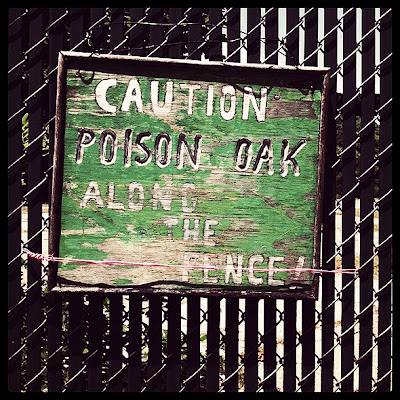 |
| What is poison oak? |
For most Europeans, the poison oak is a bit of a mystery. We hear about it in popular American television programs, but this only causes confusion as there is no such thing as poison oak in Europe - should we be worried?
No, luckily for us, poison oak is a deciduous shrub native only to North America, and is found widespread throughout the mountains and valleys of California. It thrives in shady canyons and riparian habitats, and commonly grows as a climbing vine with aerial (adventitious) roots that adhere to the trunks of oaks and sycamores.
 |
| Warning sign for poison oak |
The rash is caused by contact with an oil - urushiol, which is present in all parts of the plant, including the leaves, stems, flowers, berries, and roots.
Urushiol is an allergen, so the rash is actually an allergic reaction to the oil in the poison oak.
Indirect contact with urushiol can also cause the rash. This may happen when you touch clothing, pet fur, sporting gear, gardening tools, or other objects that have come in contact with one of these plants. But urushiol does not cause a rash on everyone who gets it on his or her skin.
The rash usually appears 8 to 48 hours after your contact with the urushiol. But it can occur from 5 hours to 15 days after touching poison oak. The rash usually takes more than a week to show up the first time you get urushiol on your skin. But the rash develops much more quickly (within 1 to 2 days) after later contacts. The rash will continue to develop in new areas over several days but only on the parts of your skin that had contact with the urushiol or those parts where the urushiol was spread by touching.
The rash is not contagious. You cannot catch or spread a rash after it appears, even if you touch it or the blister fluid, because the urushiol will already be absorbed or washed off the skin. The rash may seem to be spreading. But either it is still developing from earlier contact or you have touched something that still has urushiol on it.
The more urushiol you come in contact with, the more severe your skin reaction. Severe reactions to smaller amounts of urushiol also may occur in people who are highly sensitive to urushiol. Serious symptoms may include:
Swelling of the face, mouth, neck, genitals, or eyelids (which may prevent the eyes from opening).
Widespread, large blisters that ooze large amounts of fluid.
For related articles click onto:
HOW TO GROW THE HOLM OAK - Quercus ilex
What is Air Layering?
WHAT IS GOUT?
WHAT IS POISON OAK?
WHAT IS A STUMPERY?
WHAT IS WASABI?







No comments:
Post a Comment